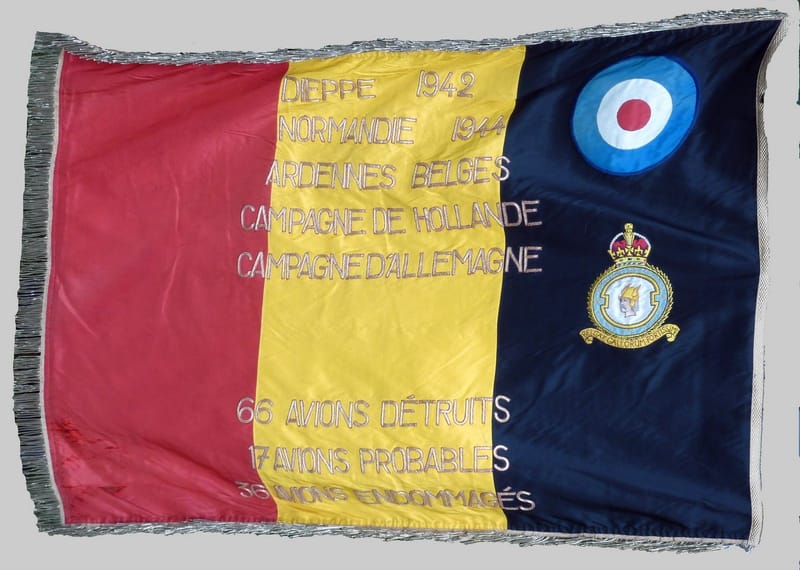About

The Belgian exiled authorities and the British Air Ministry agreed at the beginning of 1941, the creation of national units. Many Belgians who escaped to the UK were posted to 131 Squadron and 609 Squadron. As the number of pilots and ground personal (British) was sufficient, Air Ministry gave the go-ahead for the formation of the first Belgian Fighter Squadron on 1 November 1941. The squadron designated as 350 (BELGIAN) with the codes MN will be formed at Valley, formed with the nucleus of the Belgian flight of 131 Squadron, at Wales on 12 November 1941. S/Ldr Thompson was designated as the first commander of the unit. Equipped with Spitfire IIa's, the squadron began readiness duties on 22 December 1941, followed by convoy escorts and scrambles. The official inauguration of the squadron took place on 11 February 1942 at Northolt where the Belgian Minister of Defence, Camille Gutt in presence of the whole exiled Belgian Government, Sir Archibald Sinclair, Prince Bernhard of the Netherlands, Air Marshall Sholto Douglas and Air Marshall Leigh Mallory, handed over to the squadron, the Flag of the 2nd Regiment Aéronautique Militaire, recently arrived in England. Attached to 11th Group, the squadron moved to Debden in April 1942 were S/Ldr Guillaume took command of the squadron. Reequipped with Spitfire Vb's, the unit started with Sweeps over the Northern of France and Belgium. Several claims were made. They joined the Kenley Wing, flying Sweeps, Ramrods and Rhubarbs. Moved to Redhill, a glorious page for the squadron was written during operation JUBILEE (Dieppe, 19 August 1942) with claims of seven enemy aircraft destroyed (6 Fw-190 and 1 Ju-88), one probable (1 Fw-190) and twelve enemy aircraft damaged (11 Fw-190 and 1 Do-217). In December 1942 S/Ldr Guillaume was rested and S/Ldr Boussa took over command. The squadron moved to Hornchurch and Fairlop from where Circus and Rhubarbs were flown. After participating at the Army exercise Spartan in March 1943, the squadron was rested and posted to the north at Acklington. Coastal patrols and occasional scrambles were performed. Back in the south, Ramrods and Rhubarbs were performed from Digby, Rochford and Hawkinge end of the year. S/Ldr Prevot took over command on 28 December 1943 and the squadron moved to Hornchurch where it gets Spitfire IX's. The squadron's claim for 1943 was four destroyed enemy aircraft and one probable. In January, the squadron was affected to 84 Group of 2 TAF. In March 1944 they switched back to the old Spitfire Vb/c and S/Ldr Donnet took over command. After a short night training period in the north at Peterhead the squadron moved back to the south at Friston. Many Army exercises, patrols and Ramrods were flown. On 19 May 1944 a telegram announced the assassination of F/O Picard ( POW, who took part in the Great Escape) by the Gestapo on March 25, 1944. On D-Day the squadron executes recces and beachhead covers. Several pilots were lost due the bad weather and mechanical failures. S/Ldr Donnet complained to the Air Ministry and Belgian Authorities that the aircraft's were end of life and when he discovered that Belgian Government paid annually the price of two Spitfire's squadrons, came the re-equipment with Spitfire IX. The squadron returned to Sweeps and Ramrods. August saw the conversion to Spitfire XIV at Westhampnett and these were used for anti-diver patrols. A total of 6 V-1 was claimed during their anti-diver campaign. September saw the return to Ramrods and Rhubarbs. S/Ldr Collignon replaced S/Ldr Donnet in October. After many years of exile, the squadron left the English soil in December and landed at Evere (B56). Attached to 127 Wing, S/Ldr Collignon was shot down on 24 December 1944 and F/Lt Lavigne took over command ad interim. A move to Ophoven (Y32) saw his attachment to 125 Wing. The squadron's serviceable aircraft was reduced to five after the Luftwaffe attack (Operation Bodenplatte) on 1 January 1945. The 'Rundstedt Offensive', who stopped operations over Germany, restarted with S/Ldr Spencer, the new C.O. At the end of January the squadron moved to Eindhoven (B78). Due to heavy flak several pilots were killed or made POW. During an armed recce on 21 February, 350 squadron found twenty ME-109's and claimed three enemy aircraft destroyed, one probable and one damaged for no loss. Shot down on 26 February and made POW, S/Ldr Spencer was replaced by S/Ldr Wooley. An armament practice camp at Warmwell intervened in March and returned on the continent at Twenthe (B106) first and then to Varrelbusch (B113) in Germany, to support the Weser bridgehead. S/Ldr Spencer liberated on April 15th rejoined the squadron but was shot down again an made POW on April 19th after attacking a Tanker in the Bay of Wismar. S/Ldr Walsmley took over command the next day. The same day the squadron met fifteen Fw-190 and claimed four enemy aircraft destroyed one probable and two damaged for the loss of one. On 30 April the squadron claimed six destroyed enemy aircraft and one damaged for no loss followed by four others destroyed next day and his final victory, an Ar-234, on the 2nd May. Next day, the squadron took off for his last war mission where it destroyed twenty-nine trucks in the near of Kiel.
Between November 1941 and May 1945, 96 Belgians and 13 British pilots flew with 350 squadron. 23 of them were killed during operations, 3 on training and 6 whilst flying in other squadrons. 13 became POW from whom the Gestapo assassinated one. At the end of war, the 350 squadron's score stood at 51 enemy aircraft destroyed, 6 probable and 29 damaged, 6 V-1 destroyed, plus several hundreds of ground targets.